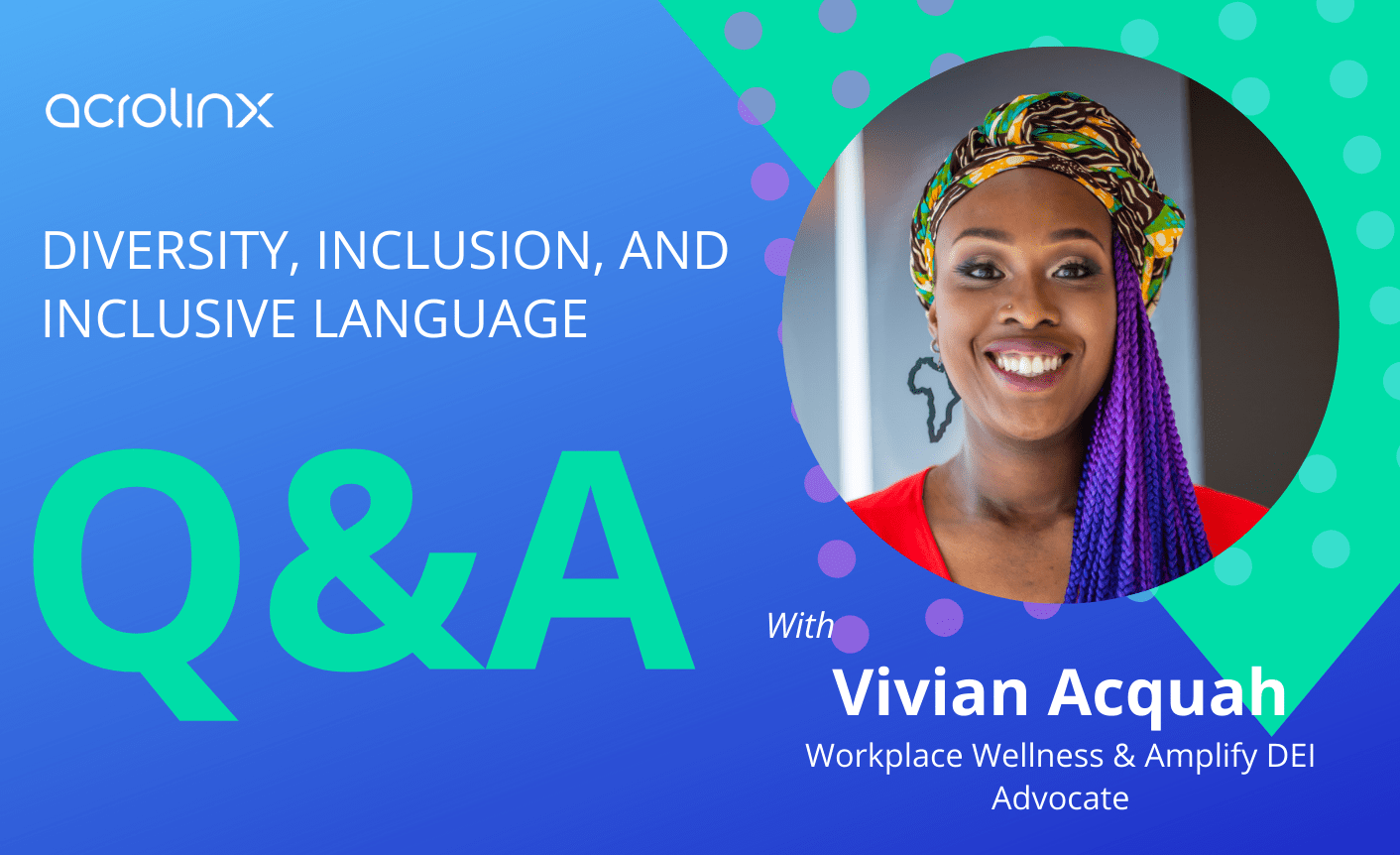
Your Questions Answered with Vivian Acquah
Did you attend the Acrolinx Inclusive Language webinar? In case you missed it, Acrolinx interviewed two guest speakers to discover how businesses can learn to communicate inclusively. We talked about the challenges and incentives to use inclusive language, what it entails, and how it’s ultimately essential to pair inclusive words with inclusive action. You can watch the recording of the webinar here.
We’d like to thank all webinar attendees for their questions, poll participation, and encouraging comments. Our in-webinar polls revealed that many attendees are familiar with diversity and inclusion, and many of you wanted to know more about how it related to enterprise content.
We received a lot of great questions and feedback, and we used your responses during and after the webinar as fodder for a follow-up interview with workplace wellness and DEI advocate, Vivian Acquah. If you’re interested in Vivian’s work, head over to her LinkedIn profile to stay up to date.
-
What are some common misconceptions or myths that people have about diversity and inclusion?
The most common misconception is that having one person representing each diversity category is enough. It’s known as “tokenism” and it can affect that person’s mental health too. It can cause burnout from the pressure to perform well enough, because in a way, that person feels they represent the bigger identity group they belong to.
To be the only person representing your gender, sexual orientation, age group, or ethnicity simply isn’t enough. It stops people from being able to speak up and advocate for themselves, and for those of us who are surrounded by people like ourselves all day, it’s easy to underestimate the necessity of being able to see ourselves in others.
It can lead to something known as “code switching.” Code switching happens when someone feels excluded from the company culture, and they feel the need to change to fit in. That could be through the way they speak, dress, or behave. It’s exhausting, and it happens when companies don’t have inclusion as a priority.
It’s so important to go beyond showcasing just one version of diversity. Can you include all the 60 labels of diversity? If you don’t know what they are, the NCU Diversity Wheel image shows intersectionality at its best.
-
Who decides what’s inclusive?
It starts from asking the people within your company, and then questioning external stakeholders. There will always be someone making a comment about what is, or isn’t, inclusive. Ultimately, we should acknowledge that it’s up to the people who are typically marginalized by lack of diversity and inclusion, to decide the parameters of their belonging.
This question indirectly came up in the webinar in comments like “there’s no natural sounding non-binary pronoun” or “inclusivity means different things depending on the country and culture.”
The point here is that you shouldn’t be guessing on behalf of the people you’re trying to include, to gauge what’s inclusive. Work with members of the communities you want to speak to, ask questions, and involve them in content development early.
For those of us who don’t question our belonging in our community or workplace, we have to realize that what might sound awkward to us at first, might actually be the exact way someone feels deeply recognized (for who they are). Any discomfort we experience while adapting to more inclusive language can’t be compared to the harm caused when we use non-inclusive language (intentional or not).
-
When is calling out helpful and when is calling in more helpful?
First, let’s define them again. Calling in is when you speak to someone about a hurtful or oppressive comment they made (or an incident) in private. Calling out is making it public.
Calling out is often when someone feels they don’t have any options left, because all the options they tried for calling in didn’t work/were not seen as important.
As a guide, when talking about diversity and inclusion topics, activate calling in before calling out. Calling out has the primary goal of raising attention to the issue, but it doesn’t always lead to change. If you use the card too soon, you can burn bridges, and there’s no way back.
Also note, there’s a difference in who has access to calling in versus calling out options. You’ll know if your diversity and inclusion initiative is working when all people at your company find it easy to start a dialogue internally when issues come up.
-
When was the last example of non-inclusive language that you remember reading/seeing?
I know everyone usually says “job descriptions” and I can’t deny that either. But actually, it was the movie Mulan (the older version). At the time, it was kind of revolutionary to see a female character play a strong role in a children’s film. But I was still struck by the tone the film took when they discovered who Mulan really was. Her future husband was also devalued by Mulan’s double identity — he had a higher ranking, but it was lowered after they found out who she was.
This brings me to the point I want to make about content. It lasts for a long time. Inclusive language is important because, although it will change, we have to be aware that the legacy of what we publish lives on. Is your content inspiring the next generation?
-
How do companies recognize and measure success in their diversity and inclusion efforts?
I can’t say it enough. Success in DEI starts from the inside. Your people at your company need to feel like your company’s diversity and inclusion efforts are real, and working — so they can stand for them and back them. If you don’t, it looks like window dressing/lip service.
You can define success criteria by asking them: where do you want to be with diversity and inclusion. Then, you can use that feedback to address topics that are company-specific. Because no diversity and inclusion initiative is the same, they’re custom-made for each company.
Every now and then, check in with people or communities that have a completely different/objective perspective on diversity and inclusion. You could join a DEI mentoring circle, attend webinars, conduct surveys, undergo unconscious bias training, or something else to avoid getting stuck in your own definition of success.
-
Do you have any books you can recommend to start understanding more about all the aspects of inclusive language?
Inclusive language will come more naturally the more we understand the context behind the words we use. It shouldn’t be a simple “don’t say this, say this” dynamic. The Acrolinx Inclusive Language Guide goes into a lot of detail and should answer some of the more language-specific questions that came up in the webinar.
In our follow-up call after the webinar, we all talked about how if you’re focused on developing your knowledge of diversity and inclusion as a whole, you can’t help but communicate more inclusively. So here’s my top three to get you started:
Reading list
- Overcoming Bias: Building Authentic Relationships Across Differences – Matthew Freeman and Tiffany Jana
- HBR’s 10 Must Reads on Diversity
- How to Be an Inclusive Leader: Your Role in Creating Cultures of Belonging Where Everyone Can Thrive
Theresa (who was also a webinar panelist) also recommended a great book in German! It’s about how language influences our thinking and politics and how it feels to “be at home” in several languages with the limitations and freedoms language can give. It’s called:
Any last words?
Yes! The power of diversity unlocks creativity and innovation. I feel like this conversation gets more valuable every time we have it. Amplifying diversity, equity, and inclusion is my life’s work, inspired by the vision I have that my son will experience a different kind of workforce one day.
This conversation has the potential to enrich the lives of all people. I’m so excited to see how Acrolinx progresses with its diversity and inclusion efforts, and how inclusive language develops in the platform!

Are you ready to create more content faster?
Schedule a demo to see how content governance and AI guardrails will drastically improve content quality, compliance, and efficiency.

Kiana Minkie
She comes to her content career from a science background and a love of storytelling. Committed to the power of intentional communication to create social change, Kiana has published a plethora of B2B content on the importance of inclusive language in the workplace. Kiana, along with the Acrolinx Marketing Team, won a Silver Stevie Award at the 18th Annual International Business Awards® for Marketing Department of the Year. She also started the Acrolinx Diversity and Inclusion committee, and is a driving force behind employee-driven inclusion efforts.




